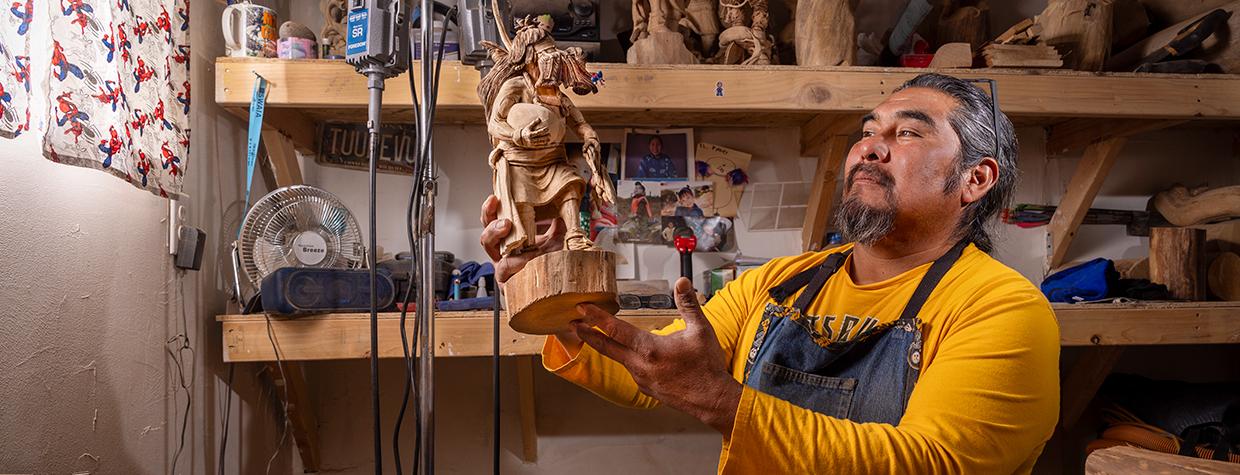Hopi carver Arthur Holmes Jr. creates his acclaimed contemporary kachinas behind his Tuba City home, in a large shed heated by a Vogelzang wood stove in winter.
The unfinished shelves and worktable are filled with carving and woodburning tools, and Holmes stacks sections of cottonwood root above a Shop-Vac and a pickup truck tire. Salvaged from his mother-in-law’s house, a black velvet painting of a dog hangs near a window covered by Spider-Man-print curtains. Action figures and a bald eagle figurine stand next to and atop an RCA bookshelf stereo unit with dual cassette players. This is a workshop, not an artist’s atelier.
Almost lost among the dad detritus are unfinished kachinas, some partly carved, others still unpainted. Holmes doesn’t work fast or in high volume, and patience is part of his process.
“I’ll be carving on one piece, and all of a sudden, it starts giving me a hard time,” he says. “Then I put it to the side and start another piece.” He points to a pair of figures known as Mudheads that he started two years ago. “And that Mudhead with the eagle up there — that’s been 15-plus years,” he says, laughing.
But something is working, because Holmes’ kachinas have brought him honors at such prestigious events as the Heard Museum Guild Indian Fair & Market in Phoenix and the Santa Fe Indian Market, where in 2023, his Talavi (Early Morning) Kachina won the top award in the Wooden Pueblo Figurative Carving and Sculpture category.
Kachina figures represent Hopi kachina dancers, who during ceremonies symbolize Katsinam, the supernatural beings that are the spirits of living things, ancestors, natural phenomena and more. The Talavi Katsina, for example, starts the ceremonial year, ringing a bell to alert villagers and singing sacred songs hoping for blessings and bountiful harvests in the coming year. The figure carries a tree, a symbol of purification, from the San Francisco Peaks, known to the Hopi people as Nuvatukaya’ovi and said to be the dwelling place of Katsina spirits.
Russ Hoover, a Scottsdale native and kachina collector in Washington state, judged the Santa Fe competition. He says Holmes is at the highest tier of carvers working in his contemporary, ultra-realistic style. Hoover notes the exceptional precision of Holmes’ work: the accuracy of the hands, fingernails and wrists; the balance between the Talavi Kachina figure and the tree it carries; and the fact that Holmes probably spent days working on details that “98 percent of people will never see. That’s next level. That’s a complete artist. This is fine art.”
But it’s Holmes’ ability to bring the spiritual to life that Hoover finds most striking. “You can’t look at that piece and not feel something,” he says. “You may not know exactly what you’re feeling, but you know something special is happening. … The spiritual aspect of his vision, combined with the technical artistry, is why the piece won.”
For all of his renown, Holmes is as unassuming as his workspace. Wearing a knit Pittsburgh Steelers beanie, he laughs easily, frequently punctuating observations with a drawn-out “Yeahhhhhhh!”
And he loves to talk about farming. There are steel bins of Hopi corn kernels on his living room floor and large stores of dried ears of corn by the shed. He works land a few miles away from his home, growing corn, beans and melons. The area gets runoff from Black Mesa, but Holmes still needs to haul in water before individually irrigating each plant.
“Most of my carvings will come to me when I’m out doing stuff in the fields,” he says. “You’re there with the world, the Earth. With spirits around you. I come away with these ideas, visions that I see out there in the cornfields. How can I make this kachina and work with the spirits around me? Sometimes I just get a toolbox and go down to the fields, put up a little canopy and carve over there.”
Growing up, he helped his father, Arthur Sr., a noted carver in his own right, cut leather and fur. But while Holmes sometimes made small kachinas for family members, he says he’s carved seriously for only about 20 years. He had gone to school for ironworking, then struggled with substance abuse before he hit bottom and ended up incarcerated. He says it was a wake-up call, and now, he’s committed to his family, takes part in ceremonies on the Hopi mesas and knows that the struggle to stay sober is ultimately his alone.
“You become your only best friend — you’re a loner,” he says. And while Holmes tells his family that he’d like to have a big warehouse shop one day, he keeps his ambitions modest.
“You can have all the money in the world and be way up here,” he says, gesturing and raising his hand high above his head. “But it can go away just like that. I always remember my grandmother telling my dad, ‘Be careful; don’t get too greedy.’ That’s what’s going to get you. When you make a name for yourself. [When you’re] on top of everybody else. Some people will call it showing off. Me, I’m the opposite. It makes me feel good that they’re thinking of my work the way they do. But deep inside, I know this is just who I am.”

